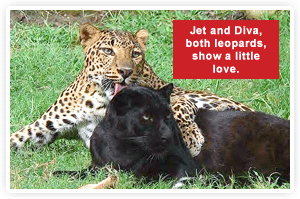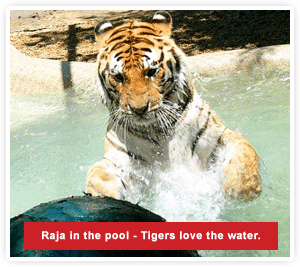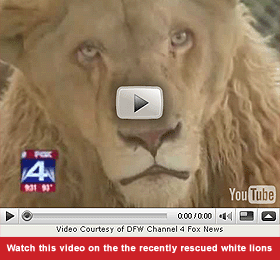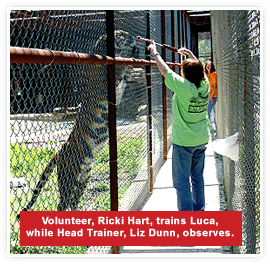It's a big family in every sense of the word -- Raja, a Bengal tiger, weighs in at 536 pounds. Nikolas, another Bengal tiger, does not weigh as much, but is a lot taller, standing 11 feet on his hind legs. These two, plus another 42 exotic cats, all call In-Sync Exotics Wildlife Rescue and Educational Center in Wylie, Texas, home and, if they could speak, they would call Vicky Keahey their savior.
 I was very fortunate to cross paths with this amazing woman, who with her mostly volunteer staff, has been saving these gorgeous creatures and providing them with a safe haven for almost 20 years. What I didn't know was the extent of abuse, neglect and abandonment of exotic felines that exists in this country and sparked her mission.
I was very fortunate to cross paths with this amazing woman, who with her mostly volunteer staff, has been saving these gorgeous creatures and providing them with a safe haven for almost 20 years. What I didn't know was the extent of abuse, neglect and abandonment of exotic felines that exists in this country and sparked her mission.
In the state of Texas, alone, there are more tigers in captivity than there are wild tigers left in the entire world. Most of them live abysmal lives in traveling circuses and roadside shows, or in people's homes as pets. Seduced by how cute they are as cubs, these people later abandon the cats when they get too big to handle. According to The Humane Society, "The business of exotic and wild animals as pets in the United States is conservatively estimated to be worth $15 billion annually." This inhumane business is fueled by exotic cat breeders, complete with all the same abusive practices as puppy mill owners -- mistreatment, over-breeding, in-breeding, malnutrition, no veterinary care and filthy conditions.
In addition to her rescue and care operation, Keahey is also a strong advocate for legislation to outlaw this abuse and uncontrolled breeding, and is an educator to the public,  organizations and government agencies about the needs, care and protection of exotic cats. With the exception of Moses, the bobcat, all of the animals at the sanctuary were born and raised in captivity, do not have the skills to survive in the wild and, as a result of despicable breeding practices, are plagued with illness and other issues. In-Sync becomes their home for life.
organizations and government agencies about the needs, care and protection of exotic cats. With the exception of Moses, the bobcat, all of the animals at the sanctuary were born and raised in captivity, do not have the skills to survive in the wild and, as a result of despicable breeding practices, are plagued with illness and other issues. In-Sync becomes their home for life.
In-Sync's story began in 1991 with a single cougar, named Tahoe, who was abandoned at a veterinary clinic where Keahey was a technician. The owner brought Tahoe in for treatment and never returned. She adopted the cougar, which was soon followed by a second cougar and then a three week old Bengal tiger, who had been badly maimed and neglected...and the seed for her nonprofit, dedicated to caring for rescued exotic felines, was planted.
In-Sync today is home to 18 tigers, 12 cougars, 6 lions, 3 leopards, 2 lynx, 2 bobcats, a serval and a coatimundi, named Nugget. For those of you who don't know (and I certainly didn't), a serval is a medium sized African wildcat and a coatimundi is part of the raccoon family. Nugget, while not an exotic cat, managed to win Keahey's heart with his story of abuse and neglect and his winning personality. So, she took him into the community.
 On the day of our interview, Keahey was called off on an emergency to take a sick cougar to Texas A&M University for treatment and had another lion who was running a fever. I was told by Chemyn Reaney, In-Sync's Volunteer Coordinator, that this is typical. She explained that so many of the cats they rescue come to the sanctuary malnourished and in poor health. They recently rescued three white lions who were confiscated from a facility by federal authorities, all of whom are emaciated and ill. Reaney and about 40 volunteers, who regularly work at the sanctuary, hope to nurse them back to health.
On the day of our interview, Keahey was called off on an emergency to take a sick cougar to Texas A&M University for treatment and had another lion who was running a fever. I was told by Chemyn Reaney, In-Sync's Volunteer Coordinator, that this is typical. She explained that so many of the cats they rescue come to the sanctuary malnourished and in poor health. They recently rescued three white lions who were confiscated from a facility by federal authorities, all of whom are emaciated and ill. Reaney and about 40 volunteers, who regularly work at the sanctuary, hope to nurse them back to health.
Reaney explained that, while cougars tend to be more popular with the pet trade, tigers usually come from the entertainment world, where they are exhibited at festivals and rodeos, for example. They are not typically treated well and often abandoned when they are no longer useful. Cougars are often sold at flea markets where someone will have a little box of cougar cubs, who have been declawed, to make them seemingly safer. The ones that they don't sell, they abandon into the wild. How can a cougar survive without claws?!
But, thanks to the efforts to Keahey and her almost entirely volunteer staff, they get to live the good life at In-Sync. It takes a good four hours and about 240 pounds of meat a day to prepare everyone's food. I learned, much to my amusement, that big cats, once they are comfortable and used to getting fed every day, are as finicky as little cats. Some like one kind of meat and some another. Some like it ground and some prefer chunks. If it's not prepared the way they like it, they simply won't eat it until the staff gets it right.
 The volunteers also spend a lot of time keeping the animals happy, exercised and engaged. The big babies evidently really like plastic barrels and orange Home Depot buckets and play includes putting the buckets on their heads and running around like that, believe it or not. They also, and I apologize for those who are squeamish, like to roll and play in different kids of feces, including the excrement of the black rhino (sounds exotic), which the volunteers are happy to provide.
The volunteers also spend a lot of time keeping the animals happy, exercised and engaged. The big babies evidently really like plastic barrels and orange Home Depot buckets and play includes putting the buckets on their heads and running around like that, believe it or not. They also, and I apologize for those who are squeamish, like to roll and play in different kids of feces, including the excrement of the black rhino (sounds exotic), which the volunteers are happy to provide.
The other side of In-Sync is training and education. About three years ago, they began a medical  handling program because they were faced with treating a tiger who had cancer and needed chemotherapy treatment. Experts from Disneyworld's Animal Program Team, which specializes in advanced animal care and welfare, trained volunteers to treat the animals for some ailments right at the sanctuary, using a form of clicker training with treats if they lie still while having their temperature taken or getting shots. And, there is outreach to the community where the public can come see and learn about the furry residents.
handling program because they were faced with treating a tiger who had cancer and needed chemotherapy treatment. Experts from Disneyworld's Animal Program Team, which specializes in advanced animal care and welfare, trained volunteers to treat the animals for some ailments right at the sanctuary, using a form of clicker training with treats if they lie still while having their temperature taken or getting shots. And, there is outreach to the community where the public can come see and learn about the furry residents.
The cost to help heal these exotic cats and provide them with the Life of Riley is hefty and the sanctuary depends completely on private donations. Food alone costs close to $100,000 a year and vet bills another $25,000, not to mention $40,000-$50,000 for each of the high end enclosures they build for the cats. If you'd like to help or learn more about this amazing organization, visit www.insyncexotics.com.
Carrie Pollare is the co-founder of the "I'm Tired of..." campaign, which was created to fight against the world's issues that we are all tired of, like animal cruelty, discrimination, world hunger, global warming, cancer, diabetes and so many more. I'm Tired of... raises money for many charities via fashionable eco friendly bracelets, made from recycled tires and metals, (creating a fun play on the word, tired), which cost just $10, so anyone can afford them. www.ImTiredOnline.com